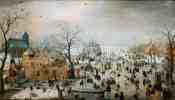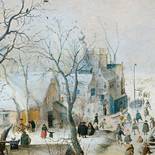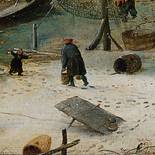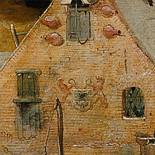![]()
 Winter Landscape with Iceskaters
Winter Landscape with Iceskaters
c. 1608; Oil on panel, 87.5 x 132 cm; Rijksmuseum, Amsterdam, Netherlands
Crowds of people are depicted on the ice in a scene that stretches far into the distance. There is considerable variety among the figures, both in clothing and in what they are doing. Some of those portrayed are having fun, while others appear to be working. Avercamp has included several daring details, such as the couple making love, the bare buttocks and the man urinating. Winter Landscape with Ice Skaters painted around 1608, is one of the earliest large winter landscapes in the Rijksmuseum.
People are enjoying themselves in different ways. Of course, many are skating - on their own, in rows, or in pairs. Some people are playing kolf, a game resembling ice hockey. Others are playing with sleighs and sailing on the ice. For some the daily toil never stops. They are shown here engaged in their work. There is a reed cutter carrying a bunch of reeds; the eel fisher carries his trident over his shoulder and the fish in a net. Beside the brewery, recognisable from its signboard, a hole has been made in the ice so that water can be drawn out for brewing beer. A ragged figure is begging for bread.
 Eel fisher
Eel fisher
 Reed cutter
Reed cutter
 Beggar
Beggar
Avercamp has included several anecdotes in his winter landscape. We see a bare behind emerging from a small boat, as well as the figure of a man relieving himself against a tree, another in a ditch, and a couple making love in a hay stack. The way the painter has signed this work is also humorous: on a tumbledown building in the right foreground the name 'Haenricus Av' appears on the wall like graffiti, with a small figure beside it. It has been suggested that fun on the ice refers to the slipperiness of the human condition. This would imply that the painting was meant as a lesson on morality. But whether this was what Avercamp intended is impossible to tell.
 Bare behinds
Bare behinds
 House with signature
House with signature
Avercamp painted winter scenes throughout the year, partly based on sketches and partly from memory. Like other seventeenth-century artists he did not go outside to paint from nature, but worked indoors in his studio. He combined his sketches to form a single composition with the result that his perspective is not always accurate. In this painting the perspective is not quite right either. The trees in the foreground and the house in the centre appear to be at eye level, while the brewery in the foreground is seen from above, from a kind of bird's-eye view. A high view point of this type is characteristic of early seventeenth-century landscapes such as this scene on the ice.
 Brewery from above
Brewery from above
 Houses at eye level
Houses at eye level
Avercamp's typically Dutch winter scene has Flemish predecessors. This appears from the composition as well as from the bird trap in the foreground. The bird trap with its cage on a small stick is an exact copy of a well-known painting of that time by Pieter Bruegel. Avercamp also appears to have emphasised the Flemish connection by painting the coat of arms of the city of Antwerp on the brewery building. The three-dimensional effect in this picture is remarkable. With its extreme depth Avercamp manages to include countless figures and anecdotal scenes.
 Bird Trap
Bird Trap
 Coat of arms of Antwerp
Coat of arms of Antwerp
The weather is hazy, the light filtered. The colours fade into the distance and shapes become vague. In this 'atmospheric perspective' depth is suggested by change of colour. The trees to the left and right of the small boat in the foreground emphasise the sense of depth and form a repoussoir. The viewer's gaze is carried into the distance, along the thickly frozen river. There are occasional red accents of colour. In the foreground a small dog appears to be chasing its own shadow. In fact this is the first painted version of the dog that Avercamp apparently placed in the wrong position. Over the years the overpainting has become transparent.
 Dog with shadow, and boat as repoussoir
Dog with shadow, and boat as repoussoir
Repoussoir: the word comes from the French 'repousser', meaning to push back. A repoussoir is an element in a composition that appears to force the remainder into the background. Large objects or figures in the foregound are ideal repoussoirs. They enhance the sense of depth. Trees and curtains are especially common repoussoirs.
Credits: The Rijksmuseum, Amsterdam.